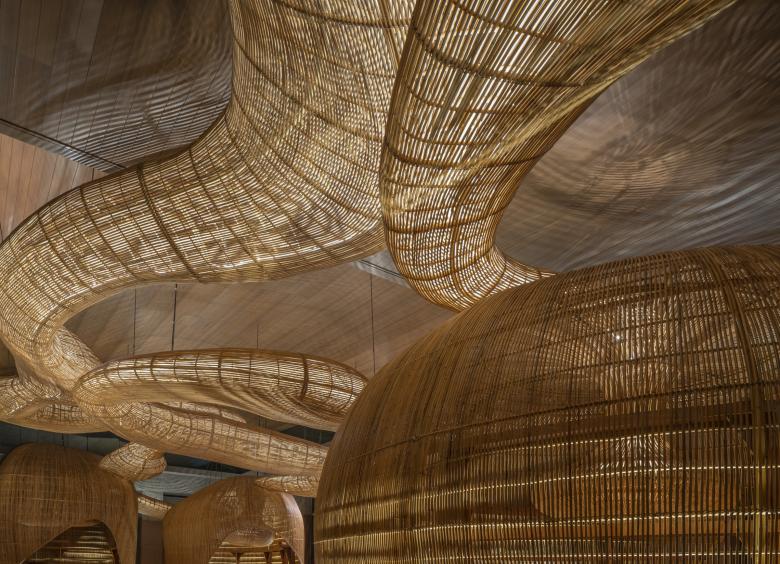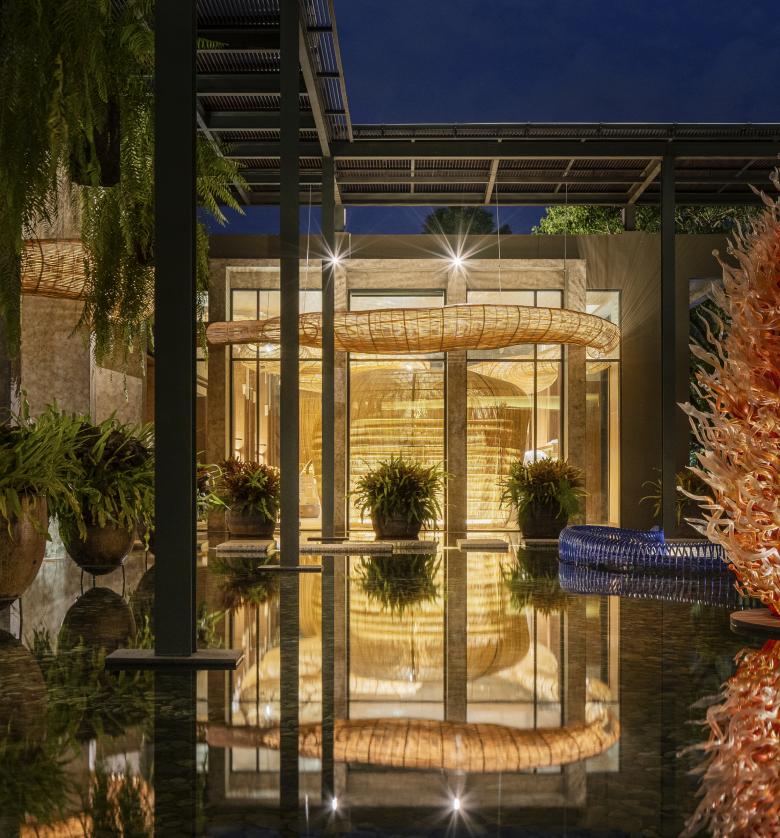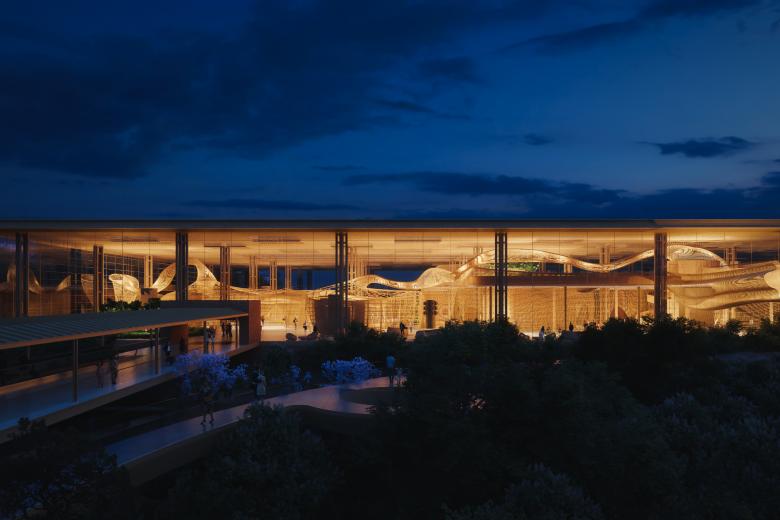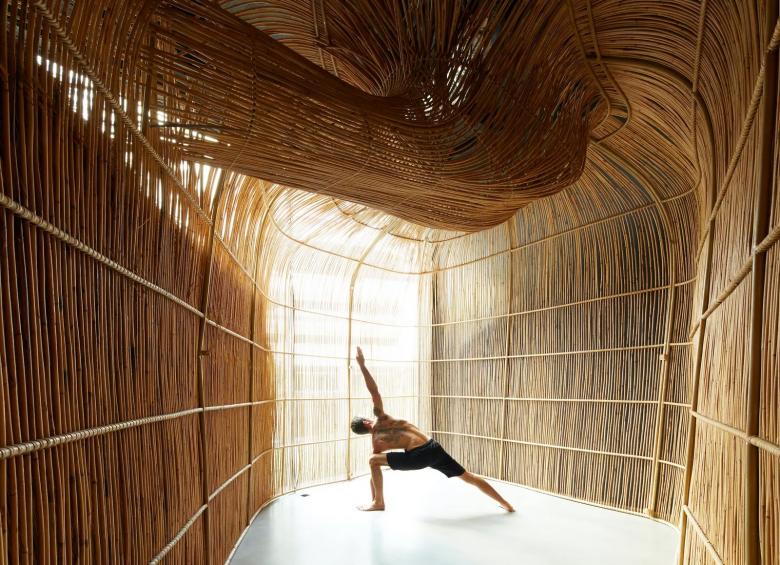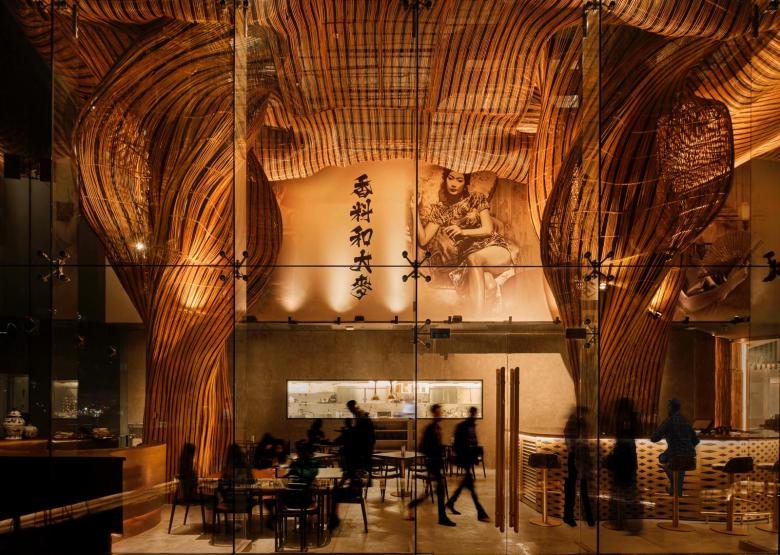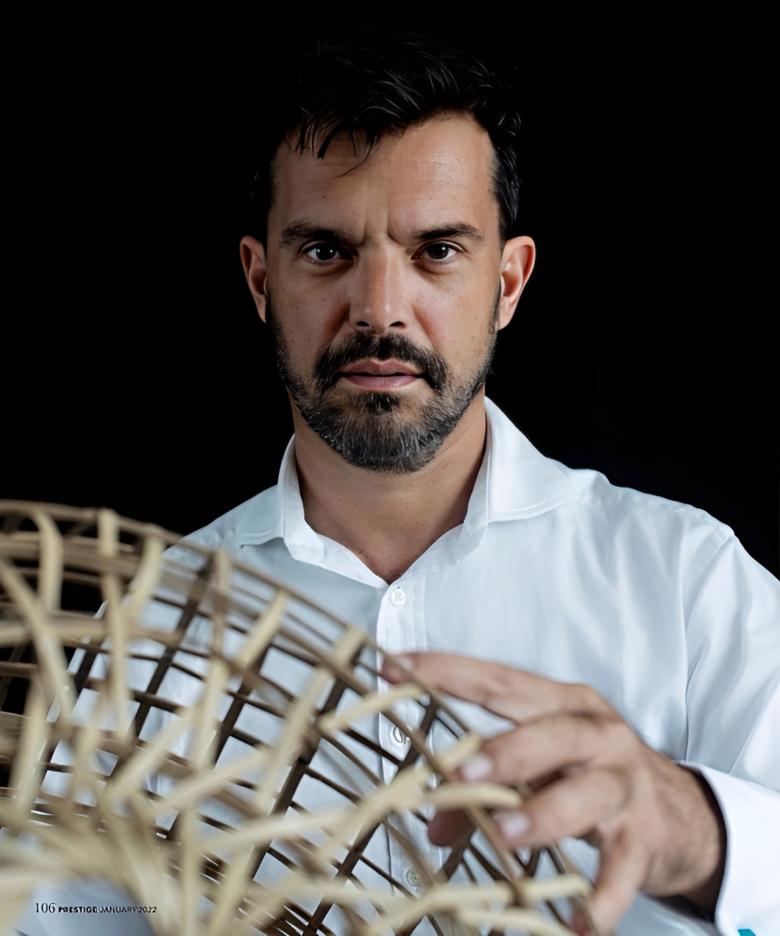2. janvier 2024
Chiang Mai Gallery, Chiang Mai, Thailand, 2022 (Photo courtesy of Enter Projects Asia)
Architect Patrick Keane of Enter Projects Asia shared with me his fascination with basketry and weaving patterns, his commitment to working with local economies and progressive engineers to push for optimizing structures and invent construction details, and starting every day with a blank page.
“We are into making things lighter and stronger,” said Patrick Keane, founder of Enter Projects Asia. He elaborated on that from his company’s main office in Phuket, Thailand, as we spoke recently over Zoom: “Heavy is expensive. Heavy is cumbersome. If you can make something light, you can make it bigger. You can turn it into a shell. You can turn it into a structure. Lightness is the way for us to challenge gravity.” Keane designs and builds such innovative structures out of rattan, bamboo, marine plywood, and other plant-based materials. His current projects include houses in Phuket, resorts in Botswana and the Philippines, a sky lounge for Delta Airlines in the new wing of the Seattle–Tacoma International Airport, a retail area at the Kempegowda International Airport in Bangalore, and a corporate office interior for a Swiss client in Abu Dhabi. All of these diverse projects use predominantly natural materials. “We want to reduce dependence on plastic, synthetic, and toxic materials as much as possible,” Keane said. “Even when we have to use concrete, we try to optimize it.”
Patrick Keane was born in 1970 in Nairobi, Kenya, where his parents were running an import-export business as well as a training agency for local secretarial and management professionals. When Keane was ten his family moved to Perth in Western Australia; his dad is Irish-Australian and mother is Anglo-Indian. Architecture runs deep in Keane’s family. His maternal third great-grandfather, Charles Andrew Welsh, was an architect who built neo-classical buildings, primarily hospitals in Bangalore, where Keane’s mother was born and grew up. Welsh’s father was a British engineer and architect who worked throughout the British Empire in the early 1700s. During most of Keane’s school years, the family lived in Bath, England. His interest in architecture stemmed from visiting historical buildings such as Wells Cathedral and Bristol Cathedral. He earned his bachelor’s degree at the University of Western Australia in 1994 and a master’s at Princeton in 1997, after which he worked in the New York offices of Peter Eisenman, Richard Meier, Emilio Ambasz, and Steven Holl, for whom he was a teaching assistant.
In addition to Phuket, Keane runs another office in Bangkok — together they employ about 20 designers, architects, and engineers — and a factory two hours north of the capital where 40 to 50 fabricators produce full-scale mock-ups. Additionally, the office collaborates with installers and crafters; some come from families that have worked on weaving chairs and baskets for seven or more generations. Their arts and crafts techniques are integrated with the latest technologies.
Enter Project Asia, originally called Enter Project, was started in 2005 in Sydney, initially working on houses and renovations in Sydney and Perth. Among the earliest highlights was a house with an ergonomic concrete roof. Finding commissions proved challenging until an unexpected phone call in 2014 presented an opportunity to work on an urban masterplan project in Phuket. Although it did not materialize, more local projects followed and in 2017 the architect moved there permanently.
Chiang Mai Gallery, Chiang Mai, Thailand, 2022 (Photo courtesy of Enter Projects Asia)
Vladimir Belogolovsky (VB): Let me start with a double question: How did you get interested in working with plant-based materials, and how did you find yourself practicing in Phuket?Patrick Keane (PK): These two are related. To be honest, my career in Australia was going nowhere. Then, seemingly out of nowhere, we got a phone call inviting us to work on an urban design project here in Phuket. We were noticed because of the vitality of our firm and the dynamic forms that we tried to explore in many of our largely unrealized projects. We experimented with the early Grasshopper program, scripting, and weaving concepts. Our client liked our work because it resonated with Southeast Asia. That’s how we first entered the region.
In the beginning, I started looking at basketry and weaving patterns, which you see everywhere here. I first came to Thailand in 2014, and from then on I started coming here often, picking up local projects along the way. In 2017, I moved here permanently to work on wellness, restaurants, and other small projects until COVID-19 started. That’s when our business started growing, although the urban masterplan project that originally brought us here never materialized.
PK: We exploded! Before coming here, we were between two and five people. And during COVID-19 we remained just a five-person firm. Our initial projects were very small. For example, a co-working space in Belgium that we designed remotely, never visiting it — we haven’t even met our client! Everything was built in Thailand (sculptural features, furniture, planters, and so on) and shipped to Waregem, outside Brussels. Originally, it was hard to find a company that would be able to build our designs. Very quickly, we decided to take over the entire production cycle — from design and fabrication to construction — and we became very versatile at that. We are working with rattan, bamboo, marine plywood, and any natural plant-based materials we can get our hands on.
In the meantime, wellness centers, rest areas, and breakout spaces have popped up everywhere and are now commonplace. Our work is overtly tactile, organic, porous, and soft; our projects integrate seamlessly with gardens, and they are badly needed, particularly in big cities in contrast to dense, urban, and hard spaces. Our biggest project today is a large retail area at Bangalore Airport with giant self-supporting pods made of rattan; they are six, seven, and eight meters high and all interconnected. There are now about 50 people there working on installing these pods.
T2 Kempegowda International Airport, Bangalore, India, under construction (Image courtesy of Enter Projects Asia)
VB: How did you get the Eco-Airport commission?PK: Again, it was a phone call. Our client wanted to incorporate spaces into their building’s shell, which was designed by SOM. They said they had seen our work and wanted to have something tactile and energy-efficient. We then had just completed a gallery for a private art collector in Chiang Mai, Thailand. That space, which is two thousand square meters, provoked our airport client in Bangalore to contact us. That was the tipping point for us. The airport remains our biggest project — we are using nine kilometers of rattan there!
PK: The very first project that specifically asked us to use natural materials was Vikasa Headquarters, a yoga studio in Bangkok, completed in 2019. Our client said, “I want something that is natural, organic, and smells nice.” That’s how it started. The idea was to try to bring a sensual space into the city. Ultimately, we designed the intertwining forms that then influenced our other projects that kept growing in scale and complexity. Apart from all the benefits that these materials bring to the environment, we try to promote local skills in arts and crafts.
PK: To be honest, we hardly have any competition. The use of inferior plastic materials remains dominant. This is catastrophic for the environment. Alternatively, rattan and bamboo are cheap. We can work with very dynamic fluid forms and spaces. The right angle is the wrong angle. I like Patrik Schumacher’s quote, “We don’t do corners anymore.” We are bringing nature into urban and corporate environments. And we are inspired by nature. The point is to bring spaces to life.
Vikasa Headquarters, Bangkok, Thailand (Photo: Edmund Sumner, courtesy of Enter Projects Asia)
VB: When you talk about your work, you use such phrases as unique combinations, meandering circulation, everything being a resource, and sensory experience. How else would you describe your work, and what kind of architecture are you trying to achieve?PK: It is about blending new technologies with such traditional arts and crafts as weaving or working with bamboo and brick. We work with forms and patterns found in nature. I am talking about behaviors such as clouds, smoke, and steam. And as far as forms and structure, we learn a lot from seashells, corals, trees, plants, leaves, and anything organic. We avoid the idea that a building could be a still object, like a box. I want the building form itself to suggest meandering circulation within. We mix programs, and we mix forms and spaces.
I see myself as a Southeast Asian architect. It is like flavor in cooking. Everyone knows what Southeast Asian food is. Everyone knows what Southeast Asian design is. Now we are attracting clients who are not in Southeast Asia. Our clients are ordering Southeast Asian designs wherever they are. We are also deeply rooted in history. To quote Peter Eisenman, who said in his 1984 essay “The End of the Classical,” “You can’t have innovation if you don’t know what classical architecture is.” At the same time, we are very autonomous; we try to start with a blank page every day. We don’t copy ideas from the internet. Every project starts with research.
PK: We try very different tools. We even started experimenting with Midjourney, a generative artificial intelligence program. We might create an end image of how we want our project to look, and we know what materials we want to use. So, the challenge is to figure out how to come up with the middle. In other words, how do we make the end and the beginning meet? How do we get these projects built? That’s what we are after. We try to break preconceptions about traditional design that go from the concept stage to design development. In a way, we are going backward, in the opposite direction. The world is changing fast, and as designers, we have to be able to change gears very quickly.
Spice & Barley, Bangkok, Thailand, 2020 (Photo courtesy of Enter Projects Asia)
VB: You have said, “The industry should not drive designers.” How so?PK: A designer is a person with ideas. The industry needs to listen to those ideas. I am against default solutions that you can simply take from the internet. I want to redefine things such as what a window frame is, for example. Or do you even need a window frame? So much of architecture depends simply on what is being manufactured and sold. I would rather use hybrid materials, work with local economies and progressive engineers to push for optimizing structures, and invent construction details. I like designers such as Thomas Heatherwick, who is pushing the boundaries. That’s my goal as well.
PK: It would have to be several projects. First, it was our yoga studio that opened opportunities for us to work with regional artisans and use natural materials. Then Spice & Barley Restaurant allowed us to scale our work to features that are nine meters high, which are twisting rattan columns. These projects forced us to learn and understand not only how to design projects but also how to put them together uniquely and by using agile techniques of arts and crafts. And, of course, the most significant of our projects so far is our Eco-Airport, which we are completing now. It is much bigger than anything we have done so far. It has many levels of complexity and logistics to pull it all together and make it happen. It is unique. No one had ever seen anything like this.
PK: We want our work to talk about its environment, where it is from, and how it addresses sustainability challenges. We are very serious about optimization, which we learn from nature. Porosity, the concept of balance and instability, layered materiality, and storytelling all fascinate us. And we always take another look at how a program could be tweaked and rethought. I recall a line by Banksy: “Art should comfort the disturbed and disturb the comfortable.” I think it is better to ask uncomfortable questions during the design process rather than come up with comfortable outcomes that are entirely predictable and safe.
